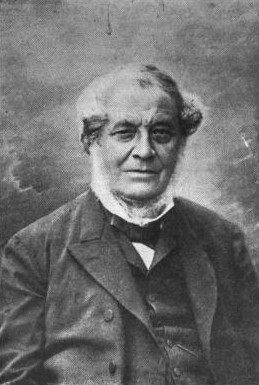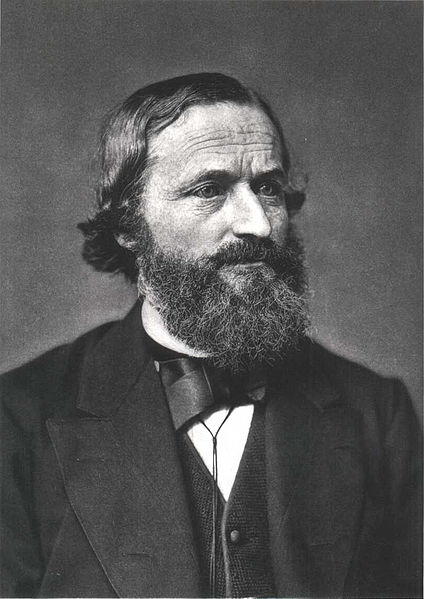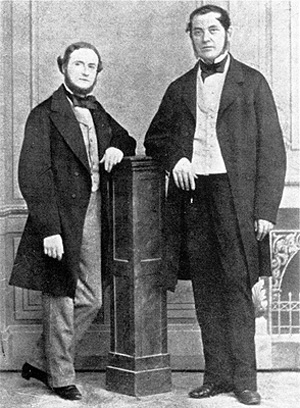<Back to Index>
- Chemist Robert Wilhelm Eberhard Bunsen, 1811
- Physicist Gustav Robert Kirchhoff, 1824
PAGE SPONSOR

Robert Wilhelm Eberhard Bunsen (30 March 1811 – 16 August 1899) was a German chemist. He investigated emission spectra of heated elements, and discovered caesium (in 1860) and rubidium (in 1861) with Gustav Kirchhoff. Bunsen developed several gas - analytical methods, was a pioneer in photochemistry, and did early work in the field of organoarsenic chemistry. With his laboratory assistant, Peter Desaga, he developed the Bunsen burner, an improvement on the laboratory burners then in use. The Bunsen – Kirchhoff Award for spectroscopy is named after Bunsen and Kirchhoff.
Robert Bunsen was born at Göttingen in 1811 in what is now the state of Lower Saxony in Germany, but was then the short lived Kingdom of Westphalia; upon the defeat of Napoleon three years later it became the Kingdom of Hanover. Robert was the youngest of four sons of the University of Göttingen's chief librarian and professor of modern philology, Christian Bunsen (1770 – 1837). Sources disagree on Robert Bunsen's exact birth date. His parish register, as well as two curricula vitae, handwritten by Bunsen himself, support the claim that 30 March 1811 is Bunsen's true birth date; however, many later sources cite 31 March as the date. According to his biographer Georg Lockemann, Bunsen himself celebrated his birthday on the 31st in his later years. Lockemann nevertheless regarded the 30th as the correct date.
After attending school in Holzminden, Bunsen matriculated at Göttingen in 1828 and studied chemistry with Friedrich Stromeyer as well as mineralogy with Johann Friedrich Ludwig Hausmann and mathematics with Carl Friedrich Gauss. After obtaining a Ph.D. in 1831, Bunsen spent 1832 and 1833 traveling in Germany, France, and Austria; Friedlieb Runge (who discovered aniline and in 1819 isolated caffeine), Justus von Liebig in Gießen, and Eilhard Mitscherlich in Bonn were among the many scientists he met on his journeys.
In 1833 Bunsen became a lecturer at Göttingen and began experimental studies of the (in)solubility of metal salts of arsenous acid. His discovery of the use of iron oxidehydrate as a precipitating agent is still today the most effective antidote against arsenic poisoning. In 1836, Bunsen succeeded Friedrich Wöhler at the Polytechnic School of Kassel. Bunsen taught there for three years, and then accepted an associate professorship at the University of Marburg, where he continued his studies on cacodyl derivatives. He was promoted to full professorship in 1841.
Bunsen's
work brought him quick and wide acclaim, partly because cacodyl, which
is extremely toxic and undergoes spontaneous combustion in dry air, is
so difficult to work with. Bunsen almost died from arsenic poisoning, and an explosion with cacodyl cost him sight in his right eye. In 1841, Bunsen created the Bunsen cell battery, using a carbon electrode instead of the expensive platinum electrode used in William Robert Grove's electrochemical cell. Early in 1851 he accepted a professorship at the University of Breslau, where he taught for three semesters.
In late 1852 Bunsen became the successor of Leopold Gmelin at the University of Heidelberg. There he used electrolysis to produce pure metals, such as chromium,magnesium, aluminium, manganese, sodium, barium, calcium and lithium. A long collaboration with Henry Enfield Roscoe began in 1852, in which they studied the photochemical formation of hydrogen chloride from hydrogen and chlorine. He discontinued his work with Roscoe in 1859 and joined Gustav Kirchhoff to study emission spectra of heated elements, a research area called spectrum analysis. For this work, Bunsen and his laboratory assistant, Peter Desaga, had perfected a special gas burner by 1855, influenced by earlier models. The newer design of Bunsen and Desaga, which provided a very hot and clean flame, is now called simply the "Bunsen burner".
There had been earlier studies of the characteristic colors of heated elements, but nothing systematic. In the summer of 1859, Kirchhoff suggested to Bunsen that he try to form prismatic spectra of these colors. By October of that year the two scientists had invented an appropriate instrument, a prototype spectroscope. Using it, they were able to identify the characteristic spectra of sodium, lithium, and potassium. After numerous laborious purifications, Bunsen proved that highly pure samples gave unique spectra. In the course of this work, Bunsen detected previously unknown new blue spectral emission lines in samples of mineral water from Dürkheim. He guessed that these lines indicated the existence of an undiscovered chemical element. After careful distillation of forty tons of this water, in the spring of 1860 he was able to isolate 17 grams of a new element. He named the element "caesium", after the Latin word for deep blue. The following year he discovered rubidium, by a similar process.
In 1860, Bunsen was elected a foreign member of the Royal Swedish Academy of Sciences.
Bunsen was one of the most universally admired scientists of his generation. He was a master teacher, devoted to his students, and they were equally devoted to him. At a time of vigorous and often caustic scientific debates, Bunsen always conducted himself as a perfect gentleman, maintaining his distance from theoretical disputes. He much preferred to work quietly in his laboratory, continuing to enrich his science with useful discoveries. As a matter of principle he never took out a patent. He never married.
When Bunsen retired at the age of 78, he shifted his work solely to geology and mineralogy, an interest which he had pursued throughout his career. He died in Heidelberg, aged 88.

Gustav Robert Kirchhoff (12 March 1824 – 17 October 1887) was a German physicist who contributed to the fundamental understanding of electrical circuits, spectroscopy, and the emission of black - body radiation by heated objects. He coined the term "black body" radiation in 1862, and two sets of independent concepts in both circuit theory and thermal emission are named "Kirchhoff's laws" after him, as well as a law of thermochemistry. The Bunsen – Kirchhoff Award for spectroscopy is named after him and his colleague, Robert Bunsen.
Gustav Kirchhoff was born in Königsberg, East Prussia, the son of Friedrich Kirchhoff, a lawyer, and Johanna Henriette Wittke. He graduated from the Albertus University of Königsberg in 1847 where he attended the mathematico - physical seminar directed by Franz Ernst Neumann and Friedrich Julius Richelot. He married Clara Richelot, the daughter of his mathematics professor Richelot. In the same year, they moved to Berlin, where he stayed until he received a professorship at Breslau.
Kirchhoff formulated his circuit laws, which are now ubiquitous in electrical engineering, in 1845, while still a student. He completed this study as a seminar exercise; it later became his doctoral dissertation. In 1857 he calculated that an electric signal in a resistanceless wire travels along the wire at the speed of light. He proposed his law of thermal radiation in 1859, and gave a proof in 1861. He was called to the University of Heidelberg in 1854, where he collaborated in spectroscopic work with Robert Bunsen. Together Kirchhoff and Bunsen discovered caesium and rubidium in 1861. At Heidelberg he ran a mathematico - physical seminar, modeled on Neumann's, with the mathematician Leo Koenigsberger. Among those who attended this seminar were Arthur Schuster and Sofia Kovalevskaya. In 1875 Kirchhoff accepted the first chair specifically dedicated to theoretical physics at Berlin.
In 1862 he was awarded the Rumford Medal for his researches on the fixed lines of the solar spectrum, and on the inversion of the bright lines in the spectra of artificial light.
He contributed greatly to the field of spectroscopy by formalizing three laws that describe the spectral composition of light emitted by incandescent objects, building substantially on the discoveries of David Alter and Anders Jonas Angstrom.
He also contributed to optics, carefully solving Maxwell's equations to provide a solid foundation for Huygen's principle (and correcting it in the process).
Kirchhoff died in 1887, and was buried in the St Matthäus Kirchhof Cemetery in Schöneberg, Berlin.
- A hot solid object produces light with a continuous spectrum.
- A hot tenuous gas produces light with spectral lines at discrete wavelengths (i.e. specific colors) which depend on the energy levels of the atoms in the gas (emission spectrum).
- A hot solid object surrounded by a cool tenuous gas (i.e., cooler than the hot object) produces light with an almost continuous spectrum which has gaps at discrete wavelengths depending on the energy levels of the atoms in the gas (absorption spectrum).
Kirchhoff did not know about the existence of energy levels in atoms. The existence of discrete spectral lines was later explained by the Bohr model of the atom, which helped lead to quantum mechanics.
Kirchhoff showed in 1858 that the variation of the heat of a chemical reaction is given by the difference in heat capacity between products and reactants: dΔH / dT = ΔCp.
Integration of this equation permits the evaluation of the heat of
reaction at one temperature from measurements at another temperature.
